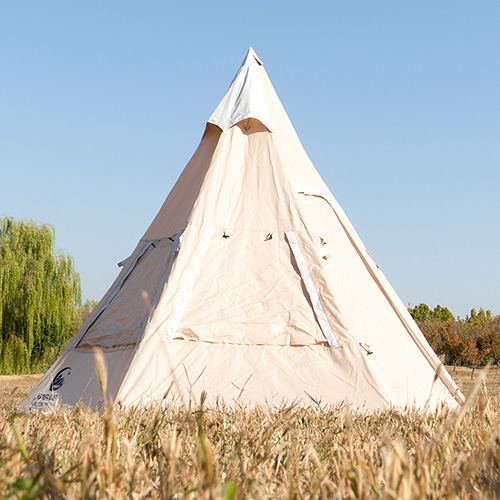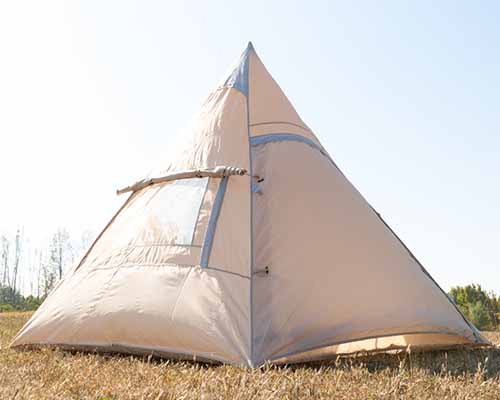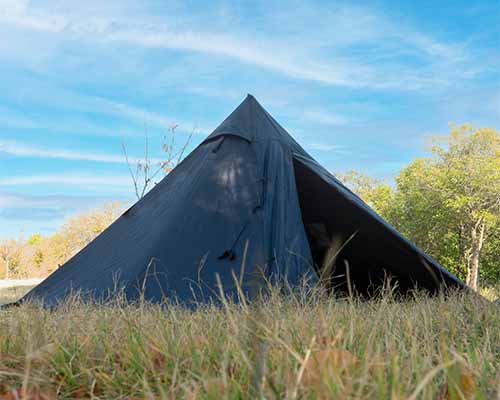
Pyramid tents have recently gained popularity among backpackers and outdoor enthusiasts. Their unique design and functionality—lightweight yet weatherproof—meet the needs of many hikers, trekkers, and campers. In this blog post, we’ll delve into everything you need to know about pyramid tents, including their features, pros and cons, and best use cases. If you’re considering purchasing a pyramid tent for your next adventure, keep reading!
Table of Contents
What is a pyramid tent?
A pyramid tent is a tent that features a distinct pyramid-shaped design. The structure typically includes a single central pole, which gives the tent its shape. This central pole can be a trekking pole or a ski pole, making it incredibly versatile for backpackers. Tents can be constructed from a tarp, which is a great option for minimalist campers looking for a lightweight, durable shelter. They are known for being highly portable, easy to set up, and capable of withstanding various weather conditions.
Key Features and Structure
- Shape: As the name suggests, cone tents have a pyramid shape. This design allows for a stable structure and effective weather resistance.
- Support: Pyramid tents usually rely on a single central pole to support their shape. This pole can be any sturdy pole, such as a trekking pole or ski pole, which makes the tent adaptable for lightweight backpacking.
- Walls: The walls of a cone tent tend to be steeply angled, which prevents snow from accumulating and makes the tent more stable in snowy conditions.
- Weight: Pyramid tents range from ultra-lightweight solo tents to larger models that can accommodate several people. For example, a 2-3 person cone tent might weigh around 1.3 kg, making it an ideal choice for weight-conscious trekkers.
- Components: These tents often don’t come with a groundsheet, so users may need to carry their own or rely on a separate waterproof tarp for the floor.
Pros of Pyramid Tents
- Lightweight: One of the primary benefits of cone tents is their lightweight construction. For ultralight backpackers, this type of tent is ideal because it minimizes weight without sacrificing essential features.
- Wind and Weather Resistance: Cone tents are known for their strong wind resistance. The single peak and steep walls of the tent make them an excellent option for exposed terrain or winter camping. They are often considered one of the most wind-resistant shelter types for ultralight gear.
- Snow Shedding: The steep walls of cone tents prevent snow from accumulating, ensuring that the tent remains stable in snowy weather. This feature makes them an excellent choice for winter camping or higher altitude adventures.
Cons of Pyramid Tents
- Stability: Single-pole cone tents, while generally sturdy, may not be the most stable in extreme weather conditions. It is essential to properly set up guy lines and secure the tent’s stake points to ensure that the shelter remains stable during high winds.
- Interior Space: The angled walls of cone tents can make headroom limited, especially near the edges. Some users report that, depending on the design, the tent can feel cramped, and condensation can become an issue if there isn’t adequate ventilation.
- Site Requirements: Since cone tents are not freestanding, you’ll need a flat, clear campsite to set them up. They are not ideal for rocky or densely wooded areas where staking and tensioning may be difficult.
- Condensation: Single-wall cone tents, like many ultralight shelters, are prone to condensation. Proper site selection and ventilation are important to mitigate this issue.
- Groundsheet Height: Some cone tents have a low bathtub-style floor that may not be high enough to prevent rain or sand from entering during specific wind or rain conditions. This issue is generally related to the cut of the outer tarp.
Pyramid Tent Usage Scenarios
Pyramid tents are well-suited for various outdoor activities and environments. They are commonly used in the following situations:
- Mountaineering and Backpacking: Pyramid tents are ideal for minimalist backpackers who need a lightweight shelter without sacrificing too much in terms of weather protection.
- Ultralight Hiking: For those seeking the lightest possible setup, the cone tent’s simplicity and compactness make it a favorite.
- Winter Camping: Due to their ability to shed snow and withstand strong winds, cone tents are a great option for camping in snow-prone areas, such as the Alps, the English Lake District, or the Peaks.
Pyramid Tent Setup Tips
Setting up a cone tent can be straightforward if you follow these simple steps:
- Lay out the Tarp: Start by spreading out the waterproof tarp on the ground and securing the corners with stakes.
- Adjust the Corners: Ensure that each corner of the tarp is adjusted to 90-degree angles for maximum stability.
- Install the Central Pole: Insert the central pole into the top of the tent and adjust its height to ensure that the tarp is taut and evenly spread.
- Secure Guy Lines: Attach and tighten the guy lines to all sides of the tent, making sure the tarp is properly tensioned. Some cone tents come with built-in vents at the peak that can be extended for added airflow.
Pyramid Tent Comparison


Here’s a comparison of some key features and specifications to consider when choosing a cone tent. This table highlights different aspects like weight, capacity, and material.
| Feature | Solo Pyramid Tent | 2-3 Person Pyramid Tent | 4-6 Person Pyramid Tent |
|---|---|---|---|
| Weight | ~0.9 kg | ~1.3 kg | ~2.5 kg |
| Capacity | 1 Person | 2-3 People | 4-6 People |
| Material | Lightweight Nylon | Durable Ripstop Fabric | Heavy-Duty Nylon |
| Weather Resistance | Wind & Waterproof | Wind & Waterproof | Excellent Wind Protection |
| Setup Time | 10-15 minutes | 15-20 minutes | 20-30 minutes |
| Ventilation | Single Vent (Peak) | Multiple Vents (Sides & Peak) | Multiple Vents (Sides & Peak) |
Conclusion
Now that you have a deeper understanding of pyramid tents and their pros and cons, it’s time to decide if they meet your camping needs. Whether you’re a minimalist backpacker or an explorer venturing into the wilderness, pyramid tents offer lightweight, weatherproof shelter capable of withstanding harsh conditions. Remember to carefully select the model best suited for your trip, and be sure to practice setting up the tent before heading out into the wilderness. Happy camping!
Need Help Choosing the Right Tent?
If you’re unsure which pyramid tent best suits your adventure, don’t hesitate to reach out! Our expert team is here to help you find the perfect shelter for your outdoor experiences. Whether you need guidance on setup or recommendations based on your specific needs, we’re just a message away.
Contact us now and get personalized advice for your next outdoor journey!
FAQ
What is a pyramid tent used for?
Pyramid tents are commonly used for backpacking, mountaineering, and camping in harsh weather conditions. Their lightweight design and ability to withstand wind and snow make them ideal for minimalist hikers, ultralight backpackers, and winter campers.
Are tents suitable for winter camping?
Yes, cone tents are excellent for winter camping. Their steep, pyramid-like shape prevents snow accumulation, and the sturdy design helps them withstand strong winds. They are considered one of the most weather-resistant types of ultralight shelters, especially in cold conditions.
Can a tent be set up without a central pole?
While most cone tents require a central pole for stability, some ultralight versions can be set up using trekking poles or ski poles. This flexibility makes them highly versatile for backpackers who prefer to travel with minimal gear.
How do I prevent condensation inside a tent?
Condensation can be a common issue with single-wall cone tents. To minimize it, choose a campsite with good airflow, avoid cooking inside, and ensure the tent is well-ventilated. Additionally, using a groundsheet or tarp to lift the tent floor can help prevent moisture from the ground.
Are cone tents difficult to set up?
Pyramid tents are relatively easy to set up, especially once you become familiar with the process. The basic steps involve laying out the tarp, securing the guy lines, and adjusting the central pole. Most tents can be set up within 15-30 minutes, depending on the model and conditions.
